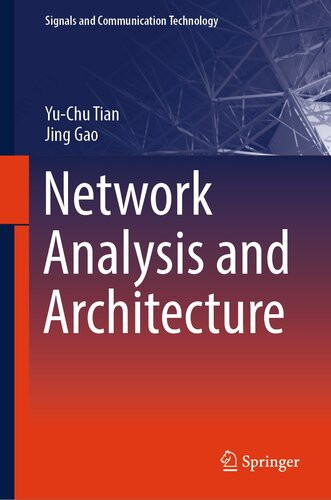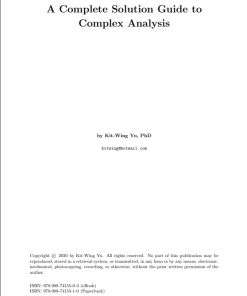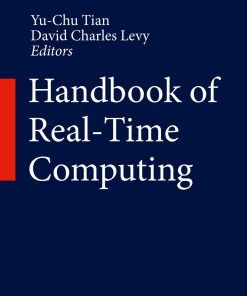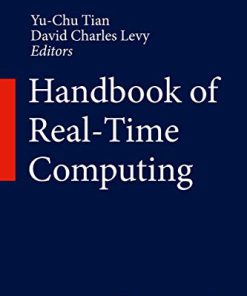Network Analysis and Architecture 1st Edition by Yu Chu Tian, Jing Gao ISBN 9819956471 978-9819956470
$50.00 Original price was: $50.00.$25.00Current price is: $25.00.
Network Analysis and Architecture 1st Edition by Yu Chu Tian, Jing Gao – Ebook PDF Instant Download/Delivery: 9819956471, 978-9819956470
Full dowload Network Analysis and Architecture 1st Edition after payment

Product details:
ISBN 10: 9819956471
ISBN 13: 978-9819956470
Author: Yu-Chu Tian, Jing Gao
Network Analysis and Architecture 1st Table of contents:
Chapter 1. Introduction
Abstract
The main theme of this book is network analysis and architecture design for network planning. While there are various types of networks, this book specifically focuses on computer networks for data communication. Therefore, it uses the term networks to specifically refer to computer networks unless specified explicitly otherwise.
Yu-Chu Tian, Jing Gao
Chapter 2. Systematic Approaches
Abstract
A computer network is a system consisting of a large number of physical and logical components that are interconnected in a complex manner. This complexity makes network planning, particularly for large-scale networks, a challenging task in terms of analysis and architecture design. To achieve a satisfactory solution to the network planning problem, it is essential to adopt systematic approaches along with a structured planning process.
Yu-Chu Tian, Jing Gao
Chapter 3. Requirements Analysis
Abstract
Requirements analysis is the first phase of systematic network planning in the systems approach, waterfall model, and top-down methodology, which are discussed previously in the last chapter. Subsequent phases will not commence until this phase is completed. The primary objective of requirements analysis is to clarify and define the network planning problems that need to be solved but have not been clearly specified. This chapter will discuss what and how requirements are developed in a systematic manner.
Yu-Chu Tian, Jing Gao
Chapter 4. Traffic Flow Analysis
Abstract
Many of the requirements developed from the requirements analysis in the previous chapter are directly or indirectly related to performance for users, applications, devices, and the network in the four-layer generic network analysis model.
Yu-Chu Tian, Jing Gao
Network Architecture
Frontmatter
Chapter 5. Network Architectural Models
Abstract
Network architecture is a high-level view of network structure from various perspectives. It describes the logical relationships of the topological and functional components of the network for network services and applications. Therefore, the development of network architecture mainly focuses on a top-level view of the logical integration of topological and functional components into the network. This implies that physical locations and detailed technical implementations of the network are not the primary purpose of network architecture, although an abstraction of some physical and technical information may appear in the architectural structure.
Yu-Chu Tian, Jing Gao
Chapter 6. Network Addressing Architecture
Abstract
A network address is used to identify a network or network device on the Internet for data communication. It is an IP address in TCP/IP networks, such as the Internet. IP addressing largely determines the format of the packet transferred over a network or the Internet. It also determines how to route and deliver traffic from end to end. Therefore, network addressing architecture is an important component in the planning and design of the overall network architecture. It characterizes how IP addressing resources can be better used, how traffic routing can be improved, and how the hierarchy, isolation, and grouping of users and devices can be supported through various addressing mechanisms and strategies.
Yu-Chu Tian, Jing Gao
Chapter 7. Network Routing Architecture
Abstract
Routing is a network-layer (layer-3) function in ISO’s seven-layer network architecture. It involves the process of finding a communication path, typically from multiple options, to deliver network traffic from its source to the intended destination. Routing decisions are made within a network, such as an enterprise network, spanning multiple networks like campus networks in a university, or across the Internet. Through these decisions, network packets are routed from their source nodes to their destination nodes, passing through intermediate nodes like gateways, routers, and firewalls. These intermediate nodes have routing protocols installed and executed to handle traffic routing and packet forwarding. Each routing device responsible for traffic routing and packet forwarding maintains a dynamic routing table, which keeps a record of routes to various network destinations. If a specific destination does not have a route listed in the routing table, the routing protocol installed on the device will search for it by communicating with other routers, typically neighboring ones.
Yu-Chu Tian, Jing Gao
Chapter 8. Network Performance Architecture
Abstract
Network performance architecture aims to describe how performance requirements, developed from requirements analysis and specifications, are fulfilled within the network during planning and design. Therefore, the task of architectural design for performance cannot be performed before conducting a comprehensive requirements analysis. To comprehend network performance architecture, it is necessary to understand the concept of performance, the characterization of performance requirements, the focus of performance architecture, and the available mechanisms and techniques that support network performance.
Yu-Chu Tian, Jing Gao
Chapter 9. Network Management Architecture
Abstract
The easiest method of managing network devices is in an ad-hoc manner. To check the status of a network device or link, send messages to the device or over the link. Then, observe and analyze the response. If the response shows our expected results, e.g., connectivity and delay, the device or link works well. Otherwise, further identify potential problems and fix them. The operating system has provided some utilities for checking the status of a network device, link, or other aspects. For example, ping, traceroute (or tracert in Windows), and netstat are examples of these utilities. By using these utilities, statistics or other specific information can be obtained from remote systems.
Yu-Chu Tian, Jing Gao
Chapter 10. Network Security and Privacy Architecture
Abstract
Network security and privacy are one of the most critical considerations in computer networking. Encompassing all aspects and components of a network, they profoundly influence network performance and the behavior of network functions. Designing a security and privacy architecture that effectively safeguards the entire network while minimizing its impact on performance and behavior is a formidable challenge due to the fact that the threats originate both internally and externally. To tackle this challenge, a systematic approach to network security and privacy design is essential, especially by employing a top-down methodology and systems approach. This chapter aims to provide guidance towards achieving this goal.
Yu-Chu Tian, Jing Gao
Network Infrastructure
Frontmatter
Chapter 11. Data Centers
Abstract
A data center is a facility that centralizes the shared IT operations and equipment of an organization for the storage and processing of data, information, and applications. Traditionally, data centers were dedicated physical spaces within a building or group of buildings, meticulously controlled and managed on premises.
Yu-Chu Tian, Jing Gao
Chapter 12. Virtualization and Cloud
Abstract
Computer networks were initially designed to connect physical network devices through wired or wireless connections. With advancements in network technologies including hardware and software, computer networks have undergone significant evolution. This evolution has driven the research, development, and implementation of flexible, programmable, and configurable networks in various applications and services. Consequently, virtual networking has emerged and gained popularity, particularly in data centers and large-scale networks.
Yu-Chu Tian, Jing Gao
Chapter 13. Building TCP/IP Socket Applications
Abstract
In the networked world, various general-purpose application-layer systems are available, such as web browsers, email clients, and social network apps. These systems are already integrated with existing network protocols to provide their functionality. For example, web browsers use the HTTP application protocol for processing hypertext. They also use TCP as the underlying transport protocol. Since these off-the-shelf application systems already embed the necessary network protocols and communications, no further development is required before they are used.
Yu-Chu Tian, Jing Gao
People also search for Network Analysis and Architecture 1st:
network analysis arcgis
network analysis arcmap
network analysis arcpro
network analysis arcgis pro
You may also like…
Uncategorized
Computers - Networking
Fiction - Family Sagas
Engineering - Telecommunications
Open Radio Access Network (O-RAN) Systems Architecture and Design 1st Edition Wim Rouwet
Computers - Information Systems
Handbook of Real Time Computing by Yu-Chu Tian 9812872507 9789812872500
Computers - Networking
Computers - Information Systems











